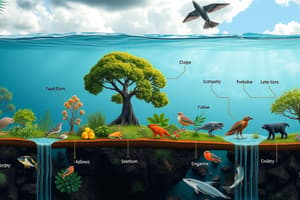Podcast
Questions and Answers
What are biotic factors in an ecosystem?
What are biotic factors in an ecosystem?
- Living processes of an ecosystem (correct)
- The abiotic components of an ecosystem
- Nonliving processes of an ecosystem
- The physical environment of an ecosystem
What does the term 'abiotic' mean?
What does the term 'abiotic' mean?
- Living
- Nonliving (correct)
- Organisms that make up an ecosystem
- Pertaining to life
What does the term 'biotic components' refer to in ecology?
What does the term 'biotic components' refer to in ecology?
- The organisms that make up an ecosystem (correct)
- The interactions between living and nonliving processes
- The products that organisms create
- The physical environment of an ecosystem
What is the defining role of producers in shaping different types of ecosystems?
What is the defining role of producers in shaping different types of ecosystems?
How do primary consumers acquire energy in ecosystems?
How do primary consumers acquire energy in ecosystems?
What is the impact of disease outbreaks caused by microscopic organisms or toxic chemicals on ecosystems?
What is the impact of disease outbreaks caused by microscopic organisms or toxic chemicals on ecosystems?
What is the maximum number of a specific organism that an area can support called?
What is the maximum number of a specific organism that an area can support called?
What can happen if humans overhunt, overfish, or overharvest plants and other producers?
What can happen if humans overhunt, overfish, or overharvest plants and other producers?
What does habitat destruction refer to in the context of human impact on ecosystems?
What does habitat destruction refer to in the context of human impact on ecosystems?
What impact did the reintroduction of gray wolves have on Yellowstone's ecosystem?
What impact did the reintroduction of gray wolves have on Yellowstone's ecosystem?
What impact can overharvesting of trees have on an ecosystem?
What impact can overharvesting of trees have on an ecosystem?
What is the carrying capacity of an ecosystem?
What is the carrying capacity of an ecosystem?
How can human contact impact ecosystems through exploitation?
How can human contact impact ecosystems through exploitation?
What happened in Yellowstone National Park when the gray wolf was exterminated and then reintroduced?
What happened in Yellowstone National Park when the gray wolf was exterminated and then reintroduced?
Flashcards are hidden until you start studying
Study Notes
Trophic Levels and Biotic Factors in Ecosystems
- Biotic factors in ecosystems are divided into three main types: producers, primary consumers, and secondary consumers, which are all integral trophic levels.
- Producers, also known as autotrophs, use energy from the Sun or other sources to create their own food through photosynthesis.
- Producers, such as plants in terrestrial ecosystems and plankton in marine ecosystems, play a defining role in shaping different types of ecosystems.
- Primary consumers acquire energy from producers, often by consuming plant material, and can impact the survival and reproduction of producers through symbiotic relationships.
- Secondary consumers, also known as carnivores, acquire energy by consuming primary consumers, and may also consume other secondary consumers.
- Decomposers break down waste and dead organisms, recycling nutrients back into the environment, and are often microscopic organisms or scavengers.
- Biotic factors have a significant impact on each other, and the absence of one factor can disrupt the balance of an ecosystem.
- Abiotic factors, such as floods and wildfires, can disrupt ecosystems, but biotic factors, such as disease outbreaks, can also have a disruptive impact.
- Disease outbreaks caused by microscopic organisms or toxic chemicals can lead to massive die-offs of species, affecting the entire ecosystem.
- An example of a disease outbreak affecting ecosystems is chytrid disease, caused by a fungus, which is affecting frog populations globally.
- The flow of energy between these trophic levels is essential for the success and survival of species in an ecosystem.
- The interdependence and interactions between these biotic factors are crucial for maintaining the balance and stability of ecosystems.
Studying That Suits You
Use AI to generate personalized quizzes and flashcards to suit your learning preferences.




